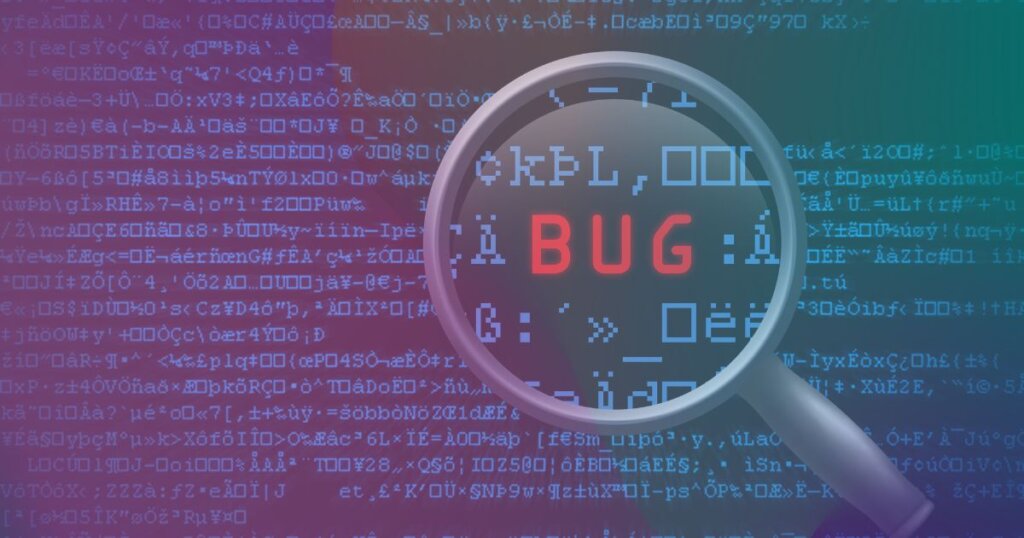
Software development is the field of computer sciences that focuses on developing computer programs through a process called Software Development Life Cycle (SDLC). A software developer is responsible to follow each step of SDLC, to design a program according to the user’s requirements. The aim is to create high-quality software in a limited time and budget. But what happens when the developer encounters a software bug?
In this blog, we will cover What are Software Bugs and What are types of software bugs? How you can get rid of bugs in easy as well as simple ways?
What Is a Software Bug?
A software bug is an error or flaw in the program, which causes it to crash or produce incorrect output. There are different possible reasons behind such errors, such as erroneous logic, incorrect syntax, or human errors. Most bugs are usually caused by human errors, which require a huge attention span to spot and debug.
Example
Consider this example, you write a perfect code for an inventory management system yet somehow the software doesn’t respond. Now, you are digging deep into your code and trying to trace the area of error. It’s been hours and you still haven’t found the problem.
After some time, you examine your code line by line and that’s when you realize that you are missing a parenthesis. You have wasted a lot of time on this minute mistake and even your compiler couldn’t notify you about it. A bug can be as simple as discussed in this scenario and still cause you a waste of time.
Also Read About: What Does “No Code Movement” Mean For A Software Developer?
What Is Debugging?
Debugging is referred to the process of identifying and removing software bugs in the code that can crash or alter its output. The method of debugging helps you to learn a lot about programming in general.
Throughout the process of SDLC, a software developer encounters many types of software bugs and errors. A rookie developer might get stuck on one such error and that results in a great loss of time and momentum. As a software developer, you must be familiar with the types of bugs you can encounter frequently and ways to remove these errors from your software.

Common Types of Software Bugs
Software bugs are broadly classified for their priority, nature, and testing types. But under these categories, we have a few common bugs that mostly occur in your programs. We are here to help you learn about types of bug in computer and how to manage them. Eventually, you will learn more about examples of bugs in software testing.
Here we have added a list of the 12 most common types of software bugs & errors and ways to identify them.
-
Syntax Bugs
-
Performance Bugs
-
Compatibility Bugs
-
Functional Bugs
-
Unit Level Bugs
-
Logical Bugs
-
System Level Integration Bugs
-
Out of Bound Bugs
-
Security Bugs
-
Usability Bugs
-
Bohrbug
-
Calculation Bugs
1. Syntax Bugs
While writing lengthy programs syntax errors frequently occur. The compiler generates an error message if there is a syntax bug present in your source code. Grammatical errors also fall in the category of syntax bugs.
Example
For example, missing a comma, a quotation mark, or misspelling a built-in word in your programming language. All these minor mistakes are syntax bugs that can obstruct your codes.
Solution
In case when a compiler fails to identify a syntax error, the software development team must review the whole program line by line to find it and debug the error.
Every programming language has different syntax rules; thus, it is important to thoroughly learn and practice the syntax of that specific language you are using for your program.
2. Performance Bugs
Performance bugs naturally occur in a lengthy program or a program that is accessing multiple files with a huge amount of data. Performance bugs are mainly responsible for slowing down the performance of a program and delaying output.
Example
You might encounter these bugs when the performance of your program degrades, or the output takes a long time to process and show results. You can also think of performance bugs as runtime errors. Another reason behind this bug could be the slow processing speed of your computer.
Note: To design and run your program efficiently, you must have hardware (PC/Laptop) that is compatible with processing lengthy and complicated codes.
Identification
Debugging a performance bug requires a deep understanding of software tools and compilers. In SDLC, the performance testing phase usually detects these bugs.
Also Read About: A Detailed Guide to the Types of Software
3. Compatibility Bugs
Whenever you are writing software that is not compatible with your hardware or cannot be processed by your operating system, you have encountered a compatibility bug. It is not very common to encounter compatibility bugs as software developers are already aware of the system requirements for the kind of software they are designing.
Identification
Compatibility bugs might not show up in the initial testing phase, hence, software developers conduct compatibility testing during the SDLC to ensure their software is rid of compatibility bugs.
4. Functional Bugs
Functional bugs contain a broad range of errors. The reasons for the occurrence of functional bugs are always lying in the coding of the software. Functional bugs can cause problems in the features of your software, website, or app.
Example
Take this example, a user clicks on a specific button on a website, but it doesn’t respond to the user’s request or crashes. Such an error can be called a functional bug. The reason behind it could be a problem with certain or many features of your software program.

Identification
To make and maintain high-quality software, it is important to root out such errors and in the SDLC, the development team identifies and solves these errors during the functional testing phase.
5. Unit Level Bugs
For the fifth most common type of bug, we have unit-level bugs that are relatively easier to fix. These bugs occur due to logical or calculation errors within a specific area/unit of code.
Identification
After coding your whole software program, you need to test every feature of it. These bugs are overlooked in the coding stages but are identified in the unit testing phase of SDLC. While doing unit testing it is easier to identify unit-level bugs and fix that specific area of your code.
Also Read About: What Is Website Usability Testing and How Does It Work?
6. Logical Bugs
Logical bugs are also commonly caused by human errors in a program. It results in software crashes or incorrect output results and disrupts the intended functionality of a program.
It occurs when a programmer misinterprets the logic of a program or assigns erroneous instructions to the compiler. These errors do not prevent a program from producing its output, however, the results of programs containing logical errors are incorrect or unintended.
Example
For example, incorrect use of operators, unintentional use of nested loops, incorrect use of parentheses, etc.
Identification
Logical errors can be identified while running your program in different parts. If a part does not produce the desired output, it hints that there might be a logical error.
7. System-Level Integration Bugs
As a software developer, if you find a system-level integration bug in your program, it will be a tough job to fix. It usually occurs when different parts of code fail to interact or process each other.
Example
Consider this example, you have created two different files which contain different parts of a code. While you import one file into another, there’s an error like the code crashes or the file data isn’t imported. There you have encountered a system-level integration bug.
Solution
To debug it you must analyze the code in detail. There could be minor details that are overlooked which results in such errors and then it becomes a time-consuming task to get rid of them.
8. Out of Bound Bugs
When a user interacts with the software in a manner that is outside its logical capabilities, an out-of-bound bug occurs. These bugs are mostly noticed when your end customer interacts with your software against the limits of your program.
Example
Suppose a program is only capable of dividing two numbers of 10 digits. The user enters a number that consists of more than 10 digits and then the program is unable to process it. Or a program made for integer values and the user enters strings.
Identification & Debugging
These bugs are not very difficult to identify and can be debugged with messages encoded in the program to notify the user about the capabilities of the software.
9. Security Bugs
Security is a major concern while designing a program or software. You need to make your software safe from threats and viruses and provide the best quality software to your customers. Software that lacks security puts your user’s private data at risk.

Security bugs occur when the program is roughly designed disregarding its safety measurements. In such cases, software bugs expose the program to potential cyber threats and hackers. The worst part is many times, these bugs go unnoticed, and the user is unaware of the attack on their software.
Examples
Examples of security bugs include network vulnerabilities like Malware, Phishing, Proxy, Spyware, Botnets, Spam, etc.
Solution
To minimize the risk of encountering security bugs, software developers critically check the code at every stage performing vulnerability assessments.
10. Usability Bugs
User Interface (UI) is an important aspect of modern software, apps, and websites. When a software interface is too complicated or unnecessarily hard to access for the user, it devalues the software. These kinds of errors are called usability bugs.
Identification
Software engineers and business analysts identify such types of software bugs while testing the usability of the software and interacting with its interface.
11. BohrBug
A BohrBug is the kind of software bug which occurs consistently under unknown conditions. BohrBugs occur when a particular operation of your software does not work even under various conditions. The opposite of BohrBug is Heisenbug which may not cause a failure in each function of your code.
Example
An example of BohrBug is a null pointer access error that crashes your program when you input a given value in a list, iterator, or variable.
Debugging
BohrBug is not very difficult to debug once you identify it after checking your code under different conditions or passing different parameters.
Note: A prior know-how of each kind of error makes it easier for the programmer to find and debug them.
12. Calculation Bugs
When a program returns an incorrect value to the end user or another code in your software, it has a calculation bug. It means that it is not producing the correct output value for your software. Calculation bugs are also known as Arithmetic bugs.
Examples
A number outside the list index range, a value of a different data type, a mathematical error, etc, are all examples of calculation bugs.
These bugs can occur for a variety of reasons such as incorrect algorithms, data type mismatch, incorrect formulas, outdated constants, etc. These errors can cause severe damage if they occur in software used for banking, accounting, ERPs, etc. But in ordinary cases, they can be simple math errors.
Identification
These types of errors are identified in the software testing phase when developers check the output of their program for different values.
Are Software Bugs Always Bad?
With the rise in popularity of the concept of software bug management, a lot of people are curious if there are any exceptions. Are bugs always bad?
Well! it depends upon the severity of damage a bug can cause. As said earlier, bugs like security bugs are very harmful and can crash your whole system. So you will always try to be safe from such bugs, however, many types of software bugs aren’t always a huge problem.
Most of the bugs can be resolved easily and while identifying them you learn a lot. It is a part of learning software development that you encounter bugs that help you understand a lot about coding complexities and improve your skills. So next time you encounter a bug make sure to remember that it is a chance for you to learn and improve your software development skills.
Easy Tips to Debug Your Software Programs
Let’s dive deeper into easy ways with which we can debug our programs.
Debugging a program is sometimes a time-consuming and hectic process. But there are many methods that you can use to remove errors from your programs. Even your compiler has its debugging tool which notifies you of many kinds of errors while you run the program. However, sometimes you get stuck on a bug that can’t be traced by your compiler.
Here are a few tips which can help you next time when you encounter a software bug.
-
Debugging Tools
-
Print Statements
-
Commenting Out
-
Quality Analysis
-
Relaxing
1. Debugging Tools
One convenient method to debug your software programs includes using debugging tools. Many famous debugging tools like Lightrun, Ghidra, Interactive Disassembler, and Fusion Reactor are available to help you debug your codes. NUnit and JMockit are automated tools that help in unit-level testing.
2. Print Statements
If you can track down the area of your code where a specific kind of bug is occurring, you can use print statements to print the values or strings being used at that particular part of your code.
Especially while using nested loops, you can print the output of each loop to determine the flow of values throughout the code. Even if you haven’t tracked down the bug, the method of using print statements can help to identify where there’s an unwanted output in your program.
3. Writing Clean Codes
Another tip for debugging different types of software bugs easily is writing cleaner codes. Like painting, music, and literature, coding is also an art. As much as you make your code simple, cleaner, and easier to read, it will help you to navigate through your code. Finding errors is much easier in neat and well-directed code. You can use comments on several parts of your code to guide you when you are reviewing your code for errors.
To get more information on how to write neat codes visit 16 Tips For Writing Cleaner Code In Any Programming Language.
4. Commenting Out
Every programming language has the option of commenting out. When you comment out a specific function or part of your code the compiler ignores it while running the program.
In the case of system-level integration bugs, you can use the commenting out method to ignore the parts of the code and then check where the error is causing a failure in the interaction between different parts of your code.
This technique is not exclusive to system-level integration bugs but can work for other kinds of bugs as well.
5. Quality Analysis
There are many tools available in the market which can help you to review the quality of your code. Code review tools are useful in static code analysis, which is necessary for delivering a trustworthy software program. While you are learning the art of building software, you will have to be focused on the quality analysis of your codes. At this stage, you will be able to remove any further bugs left in your software.
6. Relaxing
Relaxing and taking a break from examining your code is also a simple method that can help you in fixing errors. You might find it weird, but it works for many people. Writing code and tracing your errors is a time-consuming task, energy-draining, and stressful task. But while doing it, if you take a break and relax your mind, it can help you regain strength and efficiency. That’s why never forget to release the stress of programming.

Conclusion
Software Bugs are errors in source codes that malfunction the output and corrupt the interface of software designed with that code.
In this blog, we discussed the different types of software bugs and ways to resolve them in a simple way. Bugs are a part of the software development life cycle (SDLC). They cannot be avoided and as a developer, you will always find a bug in your code. It depends on whether these bugs are severe enough to damage your whole software like security bugs or simple enough to fix unit-level bugs.
Contrary to the common point of view, bugs aren’t always bad for your codes. Resolving them helps you gain experience in coding. With experience and practice, it becomes easier for a developer to pass the debugging phase.
We hope that this blog helped you learn about the various types of bugs in software testing. Our tips will also help you in the future to inspect your programs and get rid of errors easily.
What Is a Software Error?
A software error is also known as a software bug. It is a fault in the development of computer software causing it to produce erroneous output. Types of software errors are similar to bugs such as syntax errors, logical errors, coding errors, etc.
Difference Between Defect and Bug.
One main difference between a bug and a defect is that a defect occurs when the programmer deviates from the program’s requirements whereas a bug occurs when there is an error in the code.


